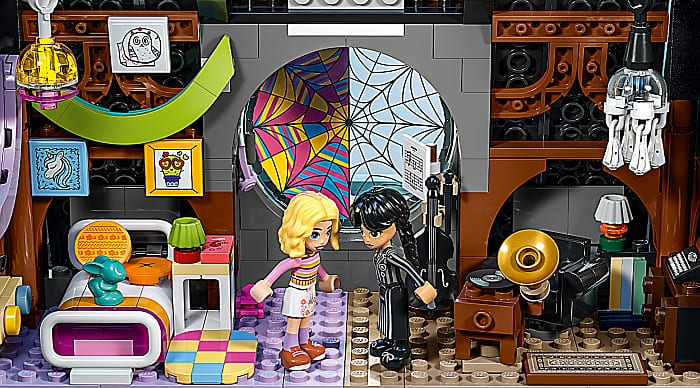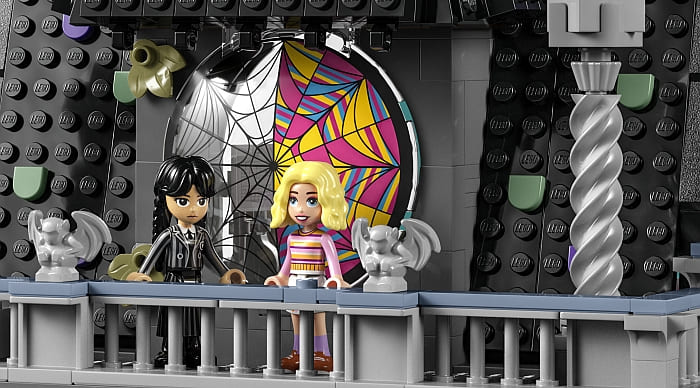(Written by William)
When rumors surfaced that LEGO was going to release sets related to Wednesday, the popular television series, I was looking forward to checking them out, even though I had a suspicion that they may be featuring mini-dolls instead of regular minifigures. I know plenty of people either like, prefer, or don’t mind mini-dolls, but I’m an old crotchety person and prefer minifigures. This meant that the #76781 LEGO Wednesday & Enid’s Dorm Room had an uphill battle for me, but I could begrudgingly accept that mini-dolls really do work well with this intellectual property.

Then there is also a $90 price tag. Is it worth it? Generally, I do like the set and the play-features. There are a couple of nifty tricks that feel fresh. Ane from the three LEGO Wednesday sets released so far, this is the only one with normal-size characters. But I think as a pure LEGO model, the price is on the high side and LEGO depends on how much fans value the TV show. But let’s take a closer look!
LEGO WEDNESDAY DORM ROOM – DUAL DIORAMA
LEGO fans looking to improve their skill with fine detail work might consider checking out LEGO’s diorama-type sets. They often have no roof and are more concerned with displaying a particular setting. For that reason, the detail work is under greater scrutiny since it is on full display.

These types of designs also make great playsets as they are easier to stick your hand in and interact with the scenery. Often a diorama neglects the outer sides of the model since they aren’t as important. So, seeing this model expand the design and make a dual diorama was rather surprising.
This is not a terribly new idea. If you ever built any of the LEGO Disney Storybook sets, they tend to have two diorama scenes of completely different sections of whatever intellectual property they are based on. What’s different about this set’s approach is that the dioramas are directly connected to one another. In other words, by extending the scene, one becomes the backdrop for the other.

LEGO designers used the very distinct bubble window that is found in Wednesday and Enid’s dorm room. The portal is even used in the series to climb out to an outdoor balcony area of the school. The trick was finding a way to create a convincing enough wall of separation so that one scene didn’t overwhelm the other.
To accomplish this task LEGO designers used a lot of height in the model. Some pretty clever LEGO Technic elements are used to secure the spired roof up top while still achieving the angles you might expect from a building that features gargoyles. Doing this meant there would be a lot of plate undersides exposed to the viewer. Therefore, they did their best to either add decorations to the underside of the roof elements or put plenty of objects in the way to obscure your view of the roof. It looks a bit busy, but does the job adequately well.
The end result feels like an evolution of both dioramas and playsets. I often avoid both these set types because when I turn the model to view a different angle, seeing the “ugly” side reminds me that it is incomplete. This model doesn’t have that limitation. Looking at it from any angle seems appropriate and doesn’t break you out of your own suspension of disbelief. Of course, this extra bit of building does come at a cost, which is another reason for the higher price.
LEGO WEDNESDAY DORM ROOM – DRAWER DISPLAYS
The model has drawers so that you can hold the mini-dolls and parts you aren’t currently playing with. I do appreciate this as it’s a safe and practical way to keep the extra pieces. This is especially true for the characters as you probably don’t want to have different versions of the same person on display at the same time in the same scene. I dare not add such pieces to my general LEGO collection as I’d probably never find them again. So, in general, I do like drawers.

And in this set, they are quite a bit upgraded from the general design. First off, each drawer has its own toggle switch to release it from the base. Each uses a double finger-hinge modified plate to sort of attach to a modified plate with clip. This connection has just enough friction to hold a drawer securely. And LEGO designers added a bent LEGO Technic axle/pin connector with bulb elements to act as a switch on the outside. Moving the switch lightly pushes on the drawer to disengage from the clip allowing you to pull the drawer out. It’s surprising how simple this is, but also how satisfying it is to use the switches.
And that’s not where the drawers stop in their cleverness. Pull a drawer out and you are greeted with a mini-doll as well as three accessories. Each is firmly connected into its own drawer unit. In essence, this doubles as a display case for your alternate mini-doll.

I was blown away by how classy the entire setup is, which once again raised my opinion of the model. Check out the video below where I demonstrate how these drawers work in action.
LEGO WEDNESDAY DORM ROOM – PARTS & STICKERS
Sadly, when it comes to parts, there are more stickered elements than printed ones in this set. Apart from the mini-dolls and Thing, which are expected to have printing, there were only three elements that feature printing. Fortunately, the large bubble window is printed. The other two pieces are 1×2 tiles that are meant to be accessories for the mini-dolls. There’s what looks to be a smartphone and the other looks to be some sort of scroll.

I was upset with all the stickers, as one of the sheets was heavily bent in on itself, which put some creases in the stickers. This is a very recent set so the stickers weren’t folded up for that long and applying them did straighten them out. However, if the sticker sheet had been left in this condition for a longer period, the stickers may have not straightened out so easily.

As for interesting elements, we do get several useful pieces. Wednesday’s cello is a nice addition to the growing range of instruments that mini-dolls and minifigures can play. I also really like the small gargoyles on the balcony. We get four of them and they make a compact yet dramatic decorative element. It is nice to see the oversized worm gears that make the swirling pillars on the balcony as well. I first ran across these in the #10334 LEGO Retro Radio set, but even then they looked like they’d have excellent decorative properties. It’s nice to see that to be true in this model.
Another part I wasn’t familiar with and am still not sure what to think about is what looks to be an open container. It is a 2×2 jumper-plate, but in its four corners, there are tiny corner panels that stick up. In this model, the designers inverted one of these to make the legs of Wednesday’s record player. Then for the top of the pillars on the outside scene, they placed a fully walled 2×2 container at an angle to form an interesting eight-pointed shape. It will be exciting to see what builders can do with this unusual element.

And finally, we can’t ignore Thing. This is the same mold found in the #76780 LEGO Wednesday Addams Figure set. It is roughly the size of a LEGO frog. The wrist is a bar so you can attach anything that will fit a normal bar to that part of the hand. The fingers are made to fit around and clutch a stud. The clutch-power is not very strong, so don’t expect it to help hold a lot of weight. It is slightly oversized when scaled with an average mini-doll/minifigure hand, but it does look neat.
LEGO WEDNESDAY DORM ROOM – FINAL THOUGHTS
Given its piece count and the fact you get two versions of two characters, not including Thing, the $90 price does feel a bit high for this model. I suppose much of the cost comes from the large plates used for the base, the drawers, and the roof, as well as licensing fees. It’s a simple fact for LEGO that more plastic equates to more cost. But I know many fans might be a little hesitant judging part count divided by price. Additionally, if you aren’t a fan of mini-dolls, this can also give you pause.

On the whole, this set is well-designed. It is both great for play as well as display. Add in the novel way you can store the extra mini-dolls, and it feels like a premium product. The challenge in building was middle of the road, so it didn’t feel too hard, nor would an experienced builder feel bored. In the video below, I talk about the set in more detail.
Ultimately, this set is made to feel premium. Collectors might also like it as it’s uncertain how many more Wednesday sets we’ll see in LEGO. And given that this is the only one scaled to mini-dolls and minifigures does add an extra level of appeal. I think it’s worth checking it out, especially if you can wait a bit and hopefully find it at a discount. It’s currently available at the LEGO Wednesday section of the Online LEGO Shop.

What do you think? Do you have any of the Wednesday sets already? Or are you planning to get them? And what do you think of the features we discussed here? Feel free to share your thoughts and own reviews in the comment section below!
And you might also like to check out the following related posts:

















